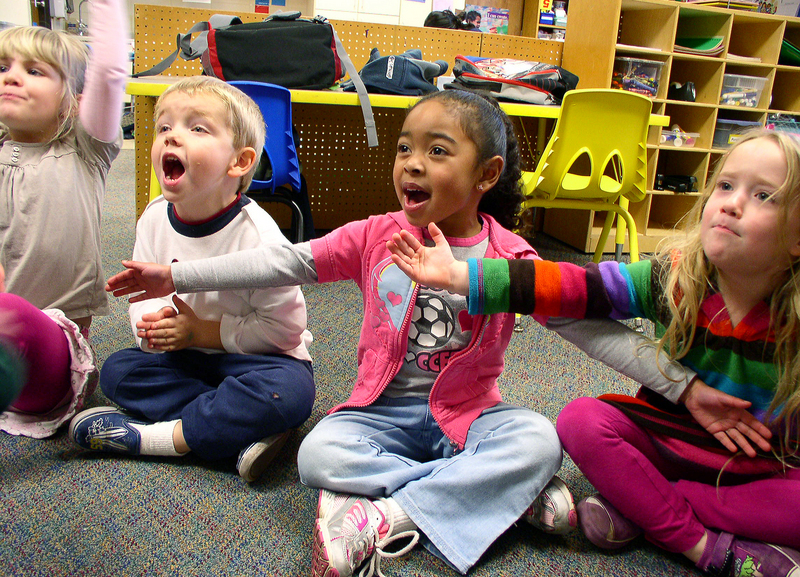
Margaret Whitfield, co-author of the forthcoming Kindergarten series, Show and Tell, offers some practical tips on using songs and games for Kindergarten classroom management.
There are many reasons for using songs and actions in the kindergarten classroom. They’re memorable, they engage different types of learners, channel energy effectively and – best of all – they’re enjoyable. But songs and actions are also fantastic for encouraging teamwork and managing the classroom.
How can songs and actions encourage teamwork?
Singing a song is in its nature a collaborative activity. All the children can join in to create something that they’re proud of. Harness this by allowing children to join in at different levels. Give them a tambourine if they’re too shy to sing – they’ll still be absorbing the language, learning the natural rhythm and intonation. If they’re super-confident, give them a line to sing solo. Try arranging the children in a circle and moving around as you sing the song – the children have to work as one or the circle collapses!
Ask groups to work together to make up actions or new verses. Have the group teach their verse or actions to the rest of the class, using props and flashcards, if appropriate. By working in groups like this, children are encouraged to collaborate and the less confident members of the class are more likely to contribute. (Try this free song activity idea from Freia Layfield, an Oxford University Press Teacher Trainer.)
Think about how you teach songs as a way of promoting teamwork. Encourage the children to be involved in the process. Begin by simple options – listen again, or sing? Clap the rhythm or ‘la-la-la’ to the tune? The children can move to different areas of the classroom according to their choices. Then have a child be in charge of the CD player. Teach the children simple phrases (Pause, please. Play it again, please.) so that they can direct the child working the CD player. With older children, once they are used to being in control, you could challenge a small group to work together with the CD player to learn the song.
How can songs and actions be a tool for classroom management?
All children have their own ideas about what they want to be doing, and it can sometimes be challenging to focus them on the job in hand, particularly if it’s not one they’re fond of.
My experience is that many very young children will respond better to commands if you sing them – however simply, and however badly. Clean up, put your shoes on, wash your hands, and so on. The same can be true with actions – it’s like a code you share with the children; for example, clap your hands to get their attention, hold them in the air, then rub them together as though washing your hands. One advantage of both these approaches is that you’re not using your voice in the usual way.
A step on from this is to turn everyday classroom routines into short chants and songs. This can be particularly effective if you use a tune that children know and like; for example, try teaching this ‘clean up’ song, sung to the tune of ‘London Bridge is falling down’:
Time to clean up everyone, everyone, everyone.
Do it together, let’s have fun,
Let’s get busy!
If you build in some actions, as well, you can ensure that children are focused on the song and not carrying on with what they were doing. In our forthcoming series, Show and Tell, my co-authors and I have included chants to support good behavior, so you can build these into your classroom routine and use them as a fun reminder. For example, when a child drops something (or looks as though he/she is about to!):
Little hands be careful,
Pick it up and hold it tight.
Little hands be careful,
And it will be alright.
You can also use songs as a reward. Leave time at the end of the lesson, pick a child whose work or behavior has been especially good, and ask them to choose their favorite English song for the class to sing.
These are just a few ways that songs and actions can be used to promote teamwork and help with classroom management. If you have any feedback or ideas of your own to share, please post!
Would you like more practical tips on classroom management and how to develop communication, collaboration and other 21st century skills with your kindergarten children?
Visit our site on Teaching 21st Century skills with confidence for free video tips, activity ideas and teaching tools.
Sign up for the webinar on Making the most of kindergarten classroom management on 18 December.


[…] "There are many reasons for using songs and actions in the kindergarten classroom. They’re memorable, they engage different types of learners, channel energy effectively and – best of all – they’re enjoyable. But songs and actions are also fantastic for encouraging teamwork and managing the classroom." […]
[…] Photo courtesy of Gryphon House Margaret Whitfield, co-author of the forthcoming Kindergarten series, Show and Tell, offers some practical tips on using songs and games for Kindergarten classroom management. […]